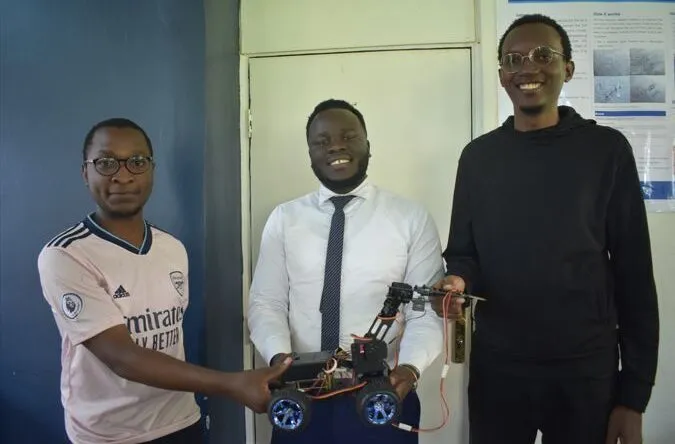By Pauline Luba
Imagine you are a farmer and you own land where you grow crops in Uganda. It is the dry season, and to ensure that your crops get adequate water, you install a modern irrigation system. How do you ensure the soil has received sufficient water for the crops?
A group of Uganda Christian University (UCU) students may have the answer. They have built a prototype for a robot that they hope will be able to measure soil moisture and temperature. The robot prototype is a medium-sized machine with wheels, designed to move through fields, using its built-in sensor to measure soil moisture and temperature.
“It dips its sensor into the ground to measure the amount of soil moisture,” Felix Kennedy Akorimo, the head of this project, said. “If there is no water, it will sense it,”
Developed using a smart irrigation system, the robot prototype uses the Global System for Mobile (GSM) communication technology to send information about the soil moisture and temperature to the farmer’s gadget. GSM is an open and digital cellular technology.

The innovation is one result of the introduction of courses in robotics, mechatronics, electronics engineering and data science at UCU’s Department of Computing and Technology. The introduction of the courses was boosted last year by Uganda Partners, through the donation of a flash forge 3D printer, an advanced virtual reality headset, a smart robot vehicle kit, a computer kit, a digital oscilloscope with a four-channel standard decoder and a triple output power supply. Soon after receiving the equipment from Uganda Partners, students started building the prototype.
Akorimo, Marvin Kauta and Gary Nkuraija, the brains behind the prototype, hope their innovation will be able to help the roughly 72% of Ugandans employed in the agriculture sector that is experiencing increasing struggles predicting weather patterns due to effects of climate change. To combat the uncertainty of rain, a considerable number are opting for irrigation to ensure that the soil is properly hydrated when the crops need the water. Knowing that the soils have the necessary moisture that can lead to high crop yields is a gap the prototype could fill.

Akorimo is a graduate of the Bachelor of Electronic and Communication Science program at UCU. As an assistant in the UCU robotics laboratory, Akorimo’s main role is training students in assembling robots. Both Kauta and Nkuraija are year-three students of Bachelor of Science in Computer Science at the university. They are active participants in the robotics lab and have engaged in the assembling of many other projects.
“Assembling the prototype was easy once I went off the blueprints,” Nkuraija said, adding: “I enjoyed this project because it was different from the others I had worked on. It needed more motors.”
Much of the prototype development time was spent programming the robot. The first code for the prototype took four weeks for Akorimo and Kauta to develop. It then took another three days for Kauta to program the robot efficiently.
“Looking at the current condition, the soil needs intervention. This robot will be able to provide that,” Kauta said. The sensor on the robot also measures temperature in the soil. For interface between the robot and the farmer, plans are underway to install a GSM technology in the machine, so that it is able to send and receive Short Message Service alerts from the farmer.
Akorimo says they were able to make headway with the project because all the necessary resources, including the internet and experts to guide them, were available. The trio also is working on other projects, such as a climate robot. The robotics laboratory at UCU is accessible to all students, regardless of the course they are pursuing.
The development of innovations such as the one of Akorimo and his colleagues will be good news to the Ugandan government that is currently prioritizing the promotion of investment in science-led innovations to be able to meet its long-term development agenda.


